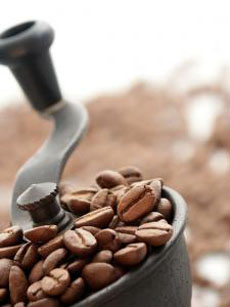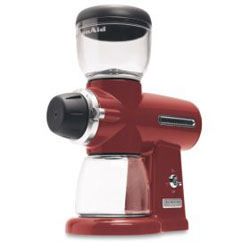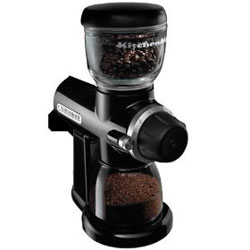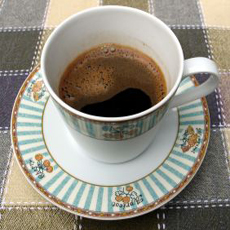CAPSULE REPORT: How much money to we spend a week...or a year...buying coffee at specialty shops or cafés? Why is “their” coffee so much better than “ours?” It’s not as if we don’t spend a fortune on our beans—in fact, we probably buy better beans than they do. We consulted with the experts and here’s their advice. This is Page 1 of a three-page article. Click on the black links below to visit other pages.
Eight Steps To Professional-Tasting Coffee
It’s not all in the beans, but in just about everything else. Sure, good beans are important—no one disputes that—but all the other elements have to be in place, too.
1. Freshly-Ground Beans. Fresh-ground beans have aromatic oils—that’s why everyone loves the smell of fresh-ground coffee. When specialty coffee shops brew their coffee, if they don’t freshly grind the beans, they open vacuum-packed bags or cans and use the entire package at once. Ground coffee will begin to go stale within 24 hours after the beans are ground (or after a bag of vacuum-packed ground coffee is opened).
If you want the absolute freshest-tasting coffee, grind your own—it only takes a minute in a coffee grinder. Otherwise, have it fresh-ground for you—but purchase as small a supply as you can, and never more than a week’s worth.
2. A Coffee Grinder. Coffee purists advocate burr grinders because a burr grinding wheel delivers consistent, uniform grounds, cutting the beans consistently rather than  crushing them as blade grinders do. This will have some impact on how the water comes into contact with the grounds, and thus has an effect on the taste of the coffee. (It’s not an issue, as is often reported, of the heat of the blade altering the flavor of the coffee.) Those who take their coffee seriously say they notice the difference as soon as they upgrade to a burr grinder. However, an October 2006 test by the Wall Street Journal, in which the reporter worked with a coffee roasting professional to test 5 new burr grinders versus an old blade model, found that while the coffee was ground more consistently by the burr models, no difference could be tasted in the brews versus the blade grinder! Thus, there seems to be no need to toss out your blade grinder, but if you’re in the market for something new, here are the story’s recommendations based on the machines tested:
crushing them as blade grinders do. This will have some impact on how the water comes into contact with the grounds, and thus has an effect on the taste of the coffee. (It’s not an issue, as is often reported, of the heat of the blade altering the flavor of the coffee.) Those who take their coffee seriously say they notice the difference as soon as they upgrade to a burr grinder. However, an October 2006 test by the Wall Street Journal, in which the reporter worked with a coffee roasting professional to test 5 new burr grinders versus an old blade model, found that while the coffee was ground more consistently by the burr models, no difference could be tasted in the brews versus the blade grinder! Thus, there seems to be no need to toss out your blade grinder, but if you’re in the market for something new, here are the story’s recommendations based on the machines tested:
- The best overall was KitchenAid Pro Line Grinder, $199.99 ($169.95 on Amazon). The best value was Solis Maestro Burr Grinder.
- Capresso Infinity Commercial Grade Conical Burr Grinder, at $89.95, ground well, but the lid was difficult to lift and there was a static charge in the grinds.
- Krupps Burr Coffee Mill, at $59.95, stalled on oilier beans and the coarse setting wasn't coarse enough. Cuisinart Automatic Burr Coffee Grinder was noisy, put static charge into the grinds, and was problematic with finer grinds.
Unfortunately, you really do get what you pay for in a burr grinder. You’ll also note that these are not tiny spice grinders—so they’re for people who really love their coffee.
- Select a medium-grind setting if you grind your own beans for a drip brewer or a press pot.
- Proper grinding is important because beans that are ground too coarsely yield coffee that tastes weak and bland. Too fine a grind can result in over-extraction and bitter-tasting coffee.
- Don’t grind your beans until you’re ready to brew the coffee. If you wake up at a certain time each morning and head for the coffee, the timing mechanism on the Capresso will grind your beans at exactly the moment you specify—a nice little time-saving luxury.
 |
 |
|
KitchenAid Pro Line Grinder. Low noise, 15 grind settings. Also in black and pearl. Click here for more information or to purchase. |
KitchenAid Pro Line Burr Grinder. In black; 15 grind settings, commercial-quality burrs. Click here for more information or to purchase. |
|
Continue To Step 2: Storing Coffee Beans
Go To The Article Index Above
Lifestyle Direct, Inc. All rights reserved. Images are the copyright of their respective owners.





 crushing them as blade grinders do. This will have some impact on how the water comes into contact with the grounds, and thus has an effect on the taste of the coffee. (It’s not an issue, as is often reported, of the heat of the blade altering the flavor of the coffee.) Those who take their coffee seriously say they notice the difference as soon as they upgrade to a burr grinder. However, an October 2006 test by the Wall Street Journal, in which the reporter worked with a coffee roasting professional to test 5 new burr grinders versus an old blade model, found that while the coffee was ground more consistently by the burr models, no difference could be tasted in the brews versus the blade grinder! Thus, there seems to be no need to toss out your blade grinder, but if you’re in the market for something new, here are the story’s recommendations based on the machines tested:
crushing them as blade grinders do. This will have some impact on how the water comes into contact with the grounds, and thus has an effect on the taste of the coffee. (It’s not an issue, as is often reported, of the heat of the blade altering the flavor of the coffee.) Those who take their coffee seriously say they notice the difference as soon as they upgrade to a burr grinder. However, an October 2006 test by the Wall Street Journal, in which the reporter worked with a coffee roasting professional to test 5 new burr grinders versus an old blade model, found that while the coffee was ground more consistently by the burr models, no difference could be tasted in the brews versus the blade grinder! Thus, there seems to be no need to toss out your blade grinder, but if you’re in the market for something new, here are the story’s recommendations based on the machines tested:
